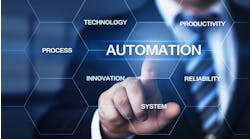The evolution of Manufacturing Execution Systems
Smart Industry: Why does Industry 4.0 need a new style MES? How will this benefit us?
Francisco: Modern consumers are demanding customization. Industry 4.0 offers an unprecedented opportunity for success, but companies must have plant floor software that is ready to adapt and ready for that journey.
Industry 4.0 is a concept revolving around cyber-physical systems—the merging of virtual and real worlds and creating a platform of interoperability between IT and operations technology. The logic behind this is that products, materials, equipment, tooling, etc. will have embedded electronics that enables them to communicate with each other and gives them computing power for a fraction of the cost.
Manufacturing Execution Systems manage and monitor the work in progress on the plant floor. MES provide a strong foundation around which manufacturers can build the Industry 4.0 application. However, Industry 4.0 cannot be implemented overnight; therefore MES need to be upgraded alongside Industry 4.0.
The shop floor will be optimized through decentralized management—all these elements will become agents and the shop-floor will become a marketplace with demand (the products being built) and supply (the equipment). The products will have all the info they need to be produced and negotiate with each other to provide agile, affordable manufacturing solutions.
The specific capabilities for scaling and shifting to coordinating autonomous, decentralized and dynamic shop-floor marketplace activity are critically important. Future MES systems must accommodate connectivity, mobile, cloud and advanced analytics.
Smart Industry: What are the new challenges posed by Industry 4.0, which new MES can address?
Francisco: As plant engineers begin to work on facilities using autonomous smart materials, and as products and production systems (CPS and CPPS) become a marketplace on the plant floor, traditional centralized UI-focused MES will not be effective. Not even for compliance, optimization and monitoring. Industry 4.0 is inherently decentralized and highly automated. Manufacturing software must respect that or the gains will not accrue as envisioned.
Industry 4.0 calls for a future of agile, affordable manufacturing fueled by technology enablers such as the Internet of Things, 3D printing, cloud computing, mobile devices and Big Data. There are various disciplines in manufacturing that need to come together at the same time, and a higher automation level is required for the separate systems to function efficiently.
I typically divide these challenges in five main categories:
1. Decentralization--Industry 4.0 is inherently a decentralized system. However, since each product is unique, it is very difficult to centralize or optimize shop floor operations in the traditional way. The MES needs context-resolution possibilities so that the CPS and CPPS have their own intelligence.
2. Vertical integration--Within an MES is an enabler for the orchestration of business processes that may be simple or complex, but nearly always requires multiple layers and groups to be involved. In Industry 4.0, CPS and CPPS communications create new data flows to integrate and vertical integration of these autonomous entities is critical to ensure that the enterprise systems respond effectively.
3. Horizontal integration--Horizontal integration focuses on supply-chain status communication among facilities and trading partners. Horizontal integration enables the smart supply chain or network to be transparent so status is always visible. This requires communication and full transparency as to the capacity and condition of the goods--communications are coordinated through the supply chain control tower. At any given time, the end customer can know the exact production status of his order.
4. Connectivity & mobile--On one side, equipment integration, typically done with well-defined and complex interfaces, will need to be complemented with connectivity. Sensors, actuators or other equipment come into play not requiring heavy systems and interfaces. On the other hand, on the operational front, combined connectivity and mobile will enable more adaptable interfaces. This mean that MES will consist of different apps, allowing you to get the equipment, downloading, and--down the road--using an app specifically built to operate that equipment.
5. Cloud & analytics--MES systems must expand their intelligence to better accommodate and cope with the diversity and volume of Big Data. Future MES must accommodate advanced offline capabilities and “real-time” analysis to trigger actions in the plant as quickly as possible, even before data is stored. This provides the infrastructure with the speed and agility it requires to cope with Industry 4.0.
Smart Industry: Why are most companies not fully aware of what current systems can do?
Francisco: On one hand, several companies have invested a lot of time and money in systems, whether through the acquisition of commercial solutions or through homegrown solutions. Most of these required significant time, effort and money and are, therefore, considered sunken costs.
Then there’s the risk to migrate shop-floor systems. These are so critical that companies cannot operate without them. A shortage of seconds or minutes may have significant financial impact. As these are so critical, companies tend to simply not touch them unless it is really necessary. As a result, they keep postponing the modernization of such systems until it’s too late.
Smart Industry: Are any industries particularly lacking in this awareness?
Francisco: That’s a very interesting question. I believe the industry sectors that were pioneers in the MES adoption, such as semiconductor or pharma, are the ones where legacy systems have the biggest share. The most advanced manufacturers will likely be the ones who will not be able to seize new developments due to their conservative, risk-adverse nature.
Manufactures looking forward with more complex products and processes in place are likely to be the early adopters of this new technology. I reckon OEM’s in electronics, automotive and medical devices are some of industry segments where Industry 4.0 will soon become a mandatory requisite, more than just a competitive advantage.




